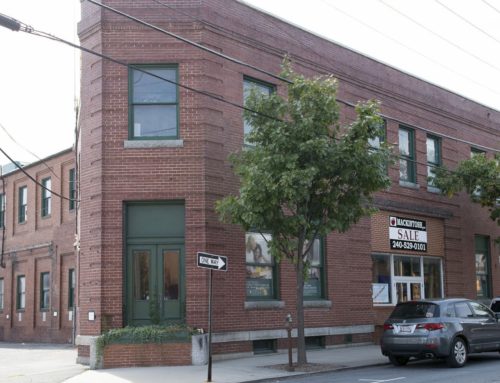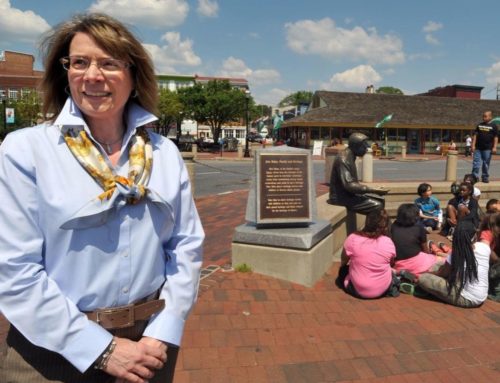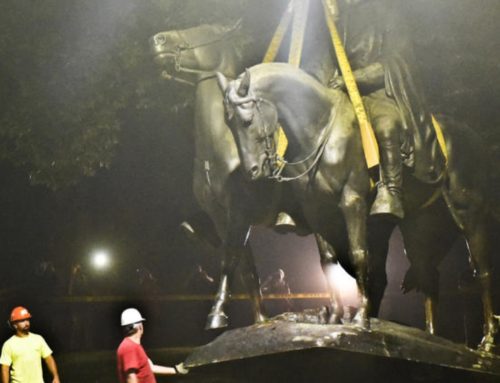Excerpt from the Washington Post:
Yards from the sleek entrance of the icy-blue MGM National Harbor casino, an eerie sight greets those lining up for table games and Cher concerts: a cluster of lonely graves atop a hill. The graves, surrounded by a parking lot and two lines of chain-link fence, don’t look much like a security risk, but anyone who approaches is challenged by a guard.
This is what remains of the contested Addison family cemetery — the final resting place of as many as 70 members of a noted Colonial clan. Two of the family’s black descendants filed a $20 million lawsuit against the casino’s developer, claiming ownership of the cemetery last month on the day before the developer sought approval to move the graves to a nearby church.
“I feel as though they’re hiding real black history,” said Christian Carter, a onetime D.C. mayoral candidate who, with fellow descendant Tanya Lyle, filed the suit against Peterson Cos., the developer behind National Harbor.
The suit is a maze of deeds, genealogies and centuries-old surveys that argues the contested land was willed, by the early 19th century, to a white Addison descendant. That descendant’s only children were with his free African American mistress — leaving valuable acreage once owned by a white family to black descendants, according to the suit.
As late as March of last year, Peterson said it planned to keep the cemetery in place “within a contemplative area surrounded by a walkway, landscaping and interpretive signage,” according to a Maryland-National Capital Park and Planning Commission report. Preservationists preferred this plan to an excavation.
“If Peterson wants to build something around it, that’s great,” said Michael Leventhal, president of the Conservancy of Broad Creek, a preservation group based in Prince George’s County. “Don’t, for the sake of money, disturb the dead.”
“We absolutely believe that will not bear out,” he said.
The complaint — and the security guard — offer a reminder that these hills have been a source of contention for decades. For some, despite the recent addition of slot machines, this is sacred ground.
The Addison family settled on the banks of the Potomac River in the 1600s in what is now Prince George’s County. John Hanson, who served as president of the Continental Congress under the Articles of Confederation and was related to the Addisons, could be buried on the site.
As centuries went by, the cemetery fell into disrepair and developers took bites out of land once owned by the family. Gravestones were vandalized, a forested bluff overlooking the Potomac was stripped of trees, and roads were constructed.
In recent years, the $100 million shopping mecca at nearby Tanger Outlets gobbled up the site of a former slave plantation. Then last year, Peterson asked the county for the right to move the Addison cemetery to a church about three miles away.
Bureaucracies churned into gear.
“The Addison Family Cemetery is completely changed from a historic rural setting to a dense mixed-use development . . . expected to become a major attraction that will draw millions of visitors a year and become a major economic engine,” read a February report on Peterson’s request from Maryland-National Capital Park and Planning Commission to the Prince George’s County Historic Preservation Commission.
For activists, some of whom opposed the development of National Harbor and its casino for several years, it was another blow.
“This is an opportunity to have something left from the historic property where National Harbor is built, to show the change over time,” said Bonnie Bick, 73. “Now what they are saying is they have to put in these skyscrapers next to it. . . . Peterson wins every time.”
Gingles said Peterson’s plans for the property “aren’t developed yet.”
After a contentious hearing last month, the nine-person Historic Preservation Commission approved Peterson’s plan to move the cemetery. Commission Supervisor Howard Berger, who didn’t vote on the plan, said “the vote speaks for itself.”
“They felt the context for the cemetery is irrevocably changed with the course of modern construction,” he said. “A more dignified environment should be found in another location.”
Yolanda Muckle, a real estate agent in Prince George’s who cast the commission’s lone dissenting vote, said she was concerned about “the whole idea of digging bodies up and moving them for development.”
“I have to sleep at night,” she said. “In good conscience, I could not raise my hand and say I agree with it.” She added: “It just makes me wonder, was their motivation prior to this that it wasn’t going to be preserved?”
The community had reason to believe the cemetery would remain. In a 2015 advertising supplement in the Washington Informer, a local newspaper focused on the African American community, MGM touted its connection to the Addisons.
“The site where the resort will sit . . . is rich with history,” said the supplement, which included an interview with Carter. “The leadership of MGM National Harbor understands that this landmark project isn’t just about building a resort.”
MGM National Harbor declined to comment, and Gingles pointed out that the company, not Peterson, paid for the advertisement.
Lyle, 53, works in communications for the U.S. Postal Service. Carter is a 34-year-old government staffing consultant who ran for D.C. mayor in 2014. He filed the cemetery lawsuit under the name “Christian Carter Addison,” saying he plans to change his name.
In the suit, filed in Prince George’s County Circuit Court without an attorney, Lyle and Carter say they are, respectively, ninth- and 11th-generation Addison heirs. They have spent considerable time demonstrating their connection to the Addisons and have taken DNA tests.
Lyle said it’s time to reinject the family’s complicated racial past into the story of National Harbor.
“That’s the reason it’s bland over here, because you’ve taken the history out,” she said. “Besides eating, shopping and gambling, what do you have?”
When Carter tried to speak about the cemetery at the March meeting of the Historic Preservation Commission, following testimony a month earlier, he was ruled out of order.
“I know you don’t want to talk to me,” Carter said as he tried to serve representatives of Peterson with his lawsuit, according to an online recording of the meeting.
“Sit down or leave the room!” said commission Chairman John Peter Thompson, banging his gavel before calling a bailiff.
The Addison family isn’t unified in opposing the cemetery move. At the meeting, Joseph Addison said that in an informal family poll, 42 of 48 Addisons supported relocating the cemetery.
“The kids and the family aren’t out there anymore,” he said at the meeting. “It’s MGM, hotels and a casino up there. And . . . the area is an urban environment.”
Carter and Lyle said they weren’t consulted for the family vote.
“I don’t see any other reason other than that we’re black,” Lyle said.
In an interview, Joseph Addison, a 62-year-old real estate agent, said he opposes the cemetery move and that the vote was taken only among his branch of the family. He also said that “it did not make any difference what we vote.”
“We don’t have a say,” he said.
French Wallop, another member of the Addison family, supported the cemetery move, but thought the plan was rushed.
“We simply did not feel it was a good place for anyone to remain with what looks like a Los Angeles mixing bowl going around it,” she said.
Carter and Lyle said other “white Addisons,” as they describe them, want the cemetery to remain where it is.
Addison Ullrich, a 71-year-old former psychologist, grew up across the road from what is now the MGM casino and remembers placing peonies on the graves as a girl. She said she wasn’t part of the Addisons’ internal vote and doesn’t understand why the cemetery needs to be moved.
“These people have been buried in the earth for all this time,” she said. “Why pull them up, expose them to the light of day?”
Although the Peterson plan won approval from the Historic Preservation Commission, the Prince George’s County State’s Attorney Office is the final arbiter on whether anyone’s eternal rest can be disturbed.
He added: “Everyone gets a voice in this process.”



